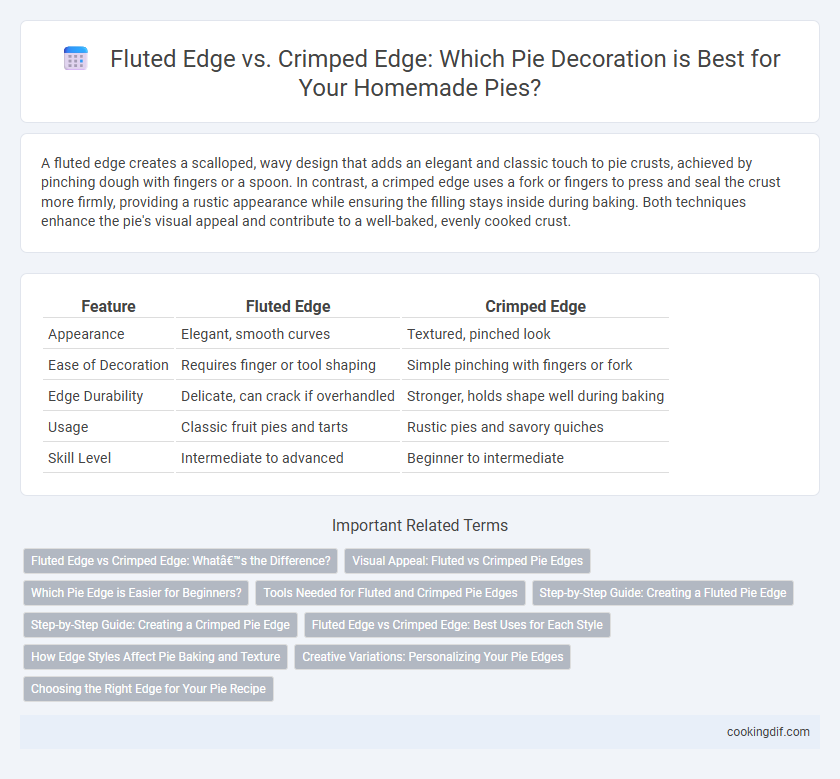A fluted edge creates a scalloped, wavy design that adds an elegant and classic touch to pie crusts, achieved by pinching dough with fingers or a spoon. In contrast, a crimped edge uses a fork or fingers to press and seal the crust more firmly, providing a rustic appearance while ensuring the filling stays inside during baking. Both techniques enhance the pie's visual appeal and contribute to a well-baked, evenly cooked crust.
Table of Comparison
| Feature | Fluted Edge | Crimped Edge |
|---|---|---|
| Appearance | Elegant, smooth curves | Textured, pinched look |
| Ease of Decoration | Requires finger or tool shaping | Simple pinching with fingers or fork |
| Edge Durability | Delicate, can crack if overhandled | Stronger, holds shape well during baking |
| Usage | Classic fruit pies and tarts | Rustic pies and savory quiches |
| Skill Level | Intermediate to advanced | Beginner to intermediate |
Fluted Edge vs Crimped Edge: What’s the Difference?
Fluted edges on pies feature a wavy, decorative pattern created by pinching the dough between fingers or using a fluting tool, providing an elegant, uniform appearance. Crimped edges involve pressing the dough with a fork or fingers to seal the crust, resulting in a more rustic and functional finish. The choice between fluted and crimped edges impacts both the pie's aesthetic appeal and the seal's effectiveness during baking.
Visual Appeal: Fluted vs Crimped Pie Edges
Fluted edges create a delicate, scalloped pattern that adds an elegant and refined appearance to pies, often achieved by pinching the dough with fingers or a tool. Crimped edges, formed by pressing dough edges together with a fork or fingers, provide a more rustic and traditional look, offering a sturdier seal to prevent filling leakage. Choosing between fluted and crimped edges affects both the pie's visual appeal and textural contrast, enhancing presentation for different occasions.
Which Pie Edge is Easier for Beginners?
Fluted edges offer a straightforward technique for beginners, requiring simple pinching of dough between fingers to create uniform waves, making it easier to master compared to crimped edges. Crimped edges demand more precision and practice to achieve consistent, tight folds using a fork or thumb and index finger, which can be challenging for novices. Choosing fluted edges accelerates learning and helps maintain a neat appearance for homemade pies.
Tools Needed for Fluted and Crimped Pie Edges
Fluted pie edges require minimal tools, often just fingers or a small spoon to create the wavy pattern, emphasizing a delicate and decorative finish. Crimped pie edges typically need a fork or pie crimper tool, which presses and seals the dough, providing a firm and uniform edge. Both techniques enhance pie presentation, but fluted edges focus on aesthetics while crimped edges prioritize durability and sealing.
Step-by-Step Guide: Creating a Fluted Pie Edge
Creating a fluted pie edge begins by pinching the dough between your thumb and forefinger to form evenly spaced scallops around the crust. Maintain consistent pressure and spacing to achieve a uniform pattern, enhancing both the pie's aesthetics and structural integrity. This technique prevents shrinkage during baking while adding a classic, decorative touch to your pie.
Step-by-Step Guide: Creating a Crimped Pie Edge
To create a crimped pie edge, start by placing the edge of the rolled dough onto the pie dish rim, allowing the excess to hang slightly over. Using your thumb and index finger from one hand, pinch the dough while pressing with the index finger of the other hand between each pinch, creating a uniform wave-like pattern. Repeat this step around the entire circumference, ensuring a consistent crimp that secures the crust and enhances the pie's decorative appeal.
Fluted Edge vs Crimped Edge: Best Uses for Each Style
Fluted edge pies showcase an elegant, scalloped pattern ideal for formal occasions and visually enhancing fruit pies, where the intricate design complements the rustic filling. Crimped edge pies provide a sturdy, sealed crust perfect for savory pies and hand pies, ensuring the filling remains enclosed during baking. Choosing between fluted and crimped edges depends on the pie's presentation needs and the type of filling, balancing aesthetics with functionality.
How Edge Styles Affect Pie Baking and Texture
Fluted edges create a decorative, scalloped crust that promotes even baking by allowing heat to circulate more uniformly around the pie's perimeter, resulting in a crisp, golden texture. Crimped edges, formed by pinching the dough between fingers or a fork, provide a tighter seal that helps retain filling moisture but may produce a denser, chewier crust. Choosing between fluted and crimped edges influences both the pie's aesthetic appeal and the final texture of the crust, impacting its overall baking performance.
Creative Variations: Personalizing Your Pie Edges
Fluted edges create a delicate, wavy pattern by pinching the dough between fingers, adding an elegant, handcrafted touch to pies. Crimped edges involve pressing the dough down with a fork or fingers to form a tighter, more structured border, ideal for sealing in fillings and enhancing texture contrast. Experimenting with these techniques allows bakers to personalize pie aesthetics, incorporating unique patterns such as braided or scalloped designs for visually striking desserts.
Choosing the Right Edge for Your Pie Recipe
Fluted edges create a delicate, scalloped finish that adds an elegant touch to fruit pies, allowing steam to escape evenly and preventing sogginess. Crimped edges provide a tighter seal, ideal for savory pies or recipes with juicy fillings, ensuring the crust holds together during baking. Selecting between fluted and crimped edges depends on the type of pie and desired presentation, optimizing both appearance and texture.
Fluted edge vs crimped edge for pie decoration Infographic

 cookingdif.com
cookingdif.com